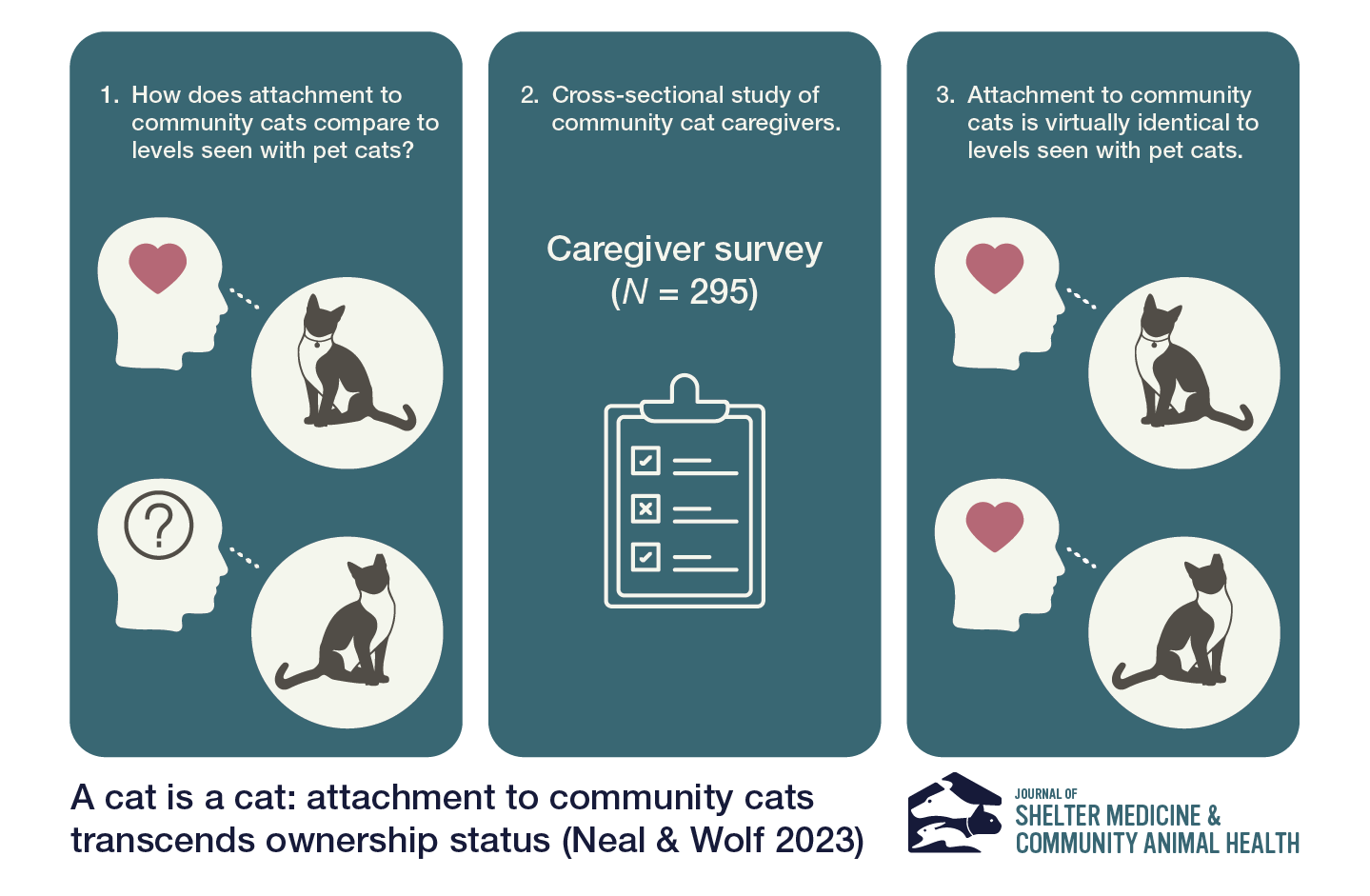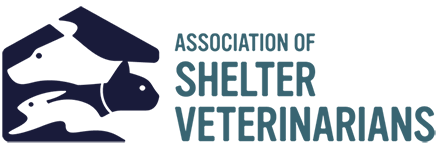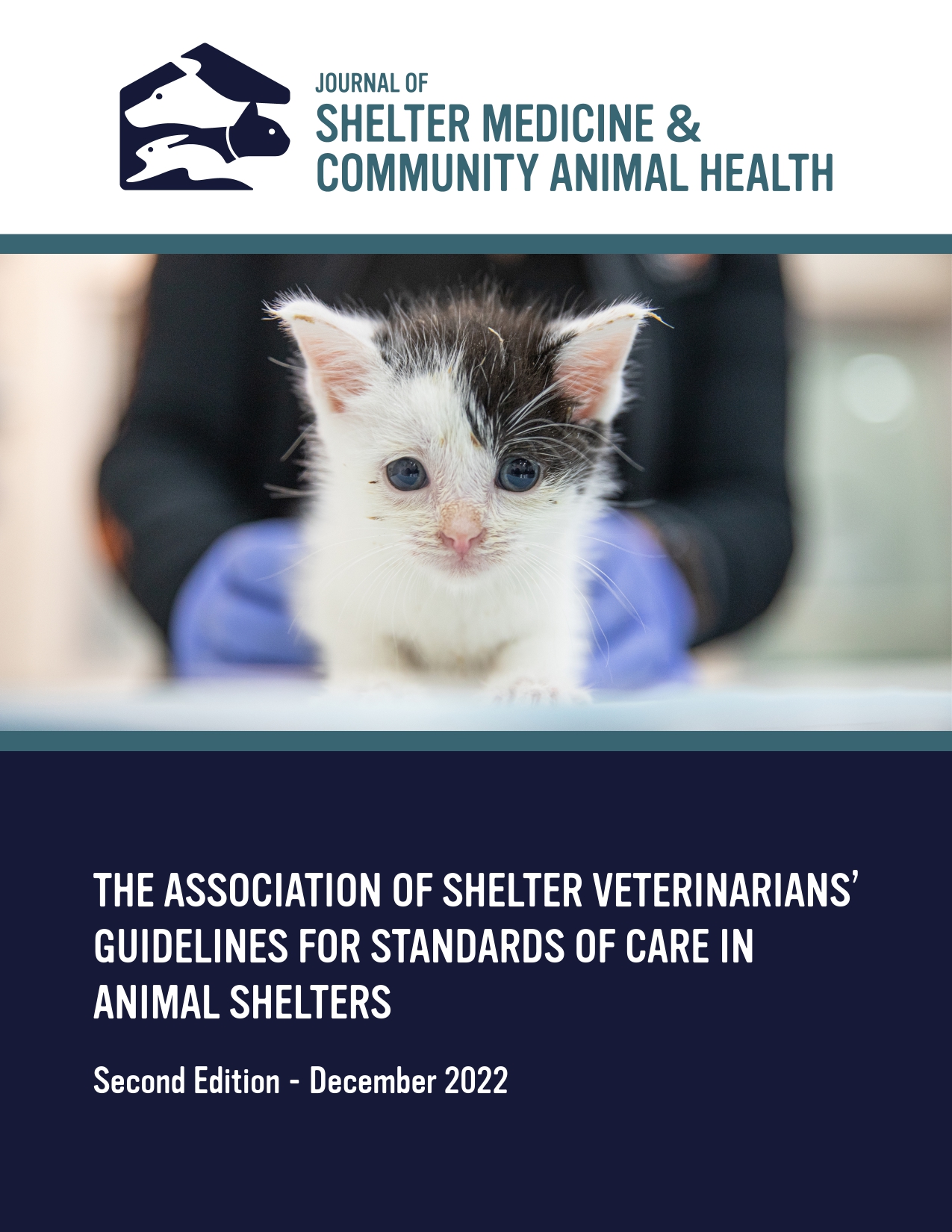A Cat Is a Cat: Attachment to Community Cats Transcends Ownership Status
DOI:
https://doi.org/10.56771/jsmcah.v2.62Keywords:
attachment, community cats, free-roaming cats, human-animal bond, trap-neuter-returnAbstract
Introduction: Despite the considerable recent interest in the human–animal bond, the relationship between community cat caregivers and the cats they care for has received relatively little attention. In addition, the instruments typically used to measure the human–animal bond contain questions specific to in-home interactions with pets or interactions representative of specific behavior traits of the animal (e.g. lap-sitting), effectively excluding community cat caregivers.
Methods: Using a slightly modified version of the Comfort from Companion Animals Scale, we surveyed community cat caregivers in Jefferson County, Kentucky, to measure the degree to which they are attached to the cats in their care. Participants for the online survey were recruited via email from a nonprofit organization that provides sterilization and wellness care for community cats in the area.
Results: Of the 329 individuals who participated in the survey, 295 (90.2%) indicated that they had provided food, water, or shelter to one or more community cats currently or within the recent past. These caregivers tend to identify as white, female, and middle-class. Levels of attachment to the cats in their care (mean: 39.6, standard deviation [SD]: 5.9) are nearly identical to those previously reported by cat owners (mean: 39.6, SD: 4.8). Monthly expenditures and other sacrifices made as part of their caregiving duties provide further evidence of the strong attachment these individuals feel for community cats.
Conclusion: The fact that community cats are unowned in no way diminishes the strength of the bond caregivers feel. Such findings have clear policy implications – validating, for example, the common practice of returning healthy cats lacking identification (i.e. collar or microchip), regardless of perceived level of sociability, to where they were found, following sterilization and vaccination.
Downloads
References
AAFP. 2023 AAFP free-roaming cat position statement. J Feline Med Surg. 2023;25(5). doi:10.1177/1098612X231173791
AAFP. Free-roaming, abandoned, and feral cats position statement. American Association of Feline Practitioners; 2012. https://www.catvets.com/guidelines/position-statements/free-roaming-abandoned-and-feral-cats. Accessed November 6, 2018.
Wells DL. The state of research on human–animal relations: implications for human health. Anthrozoös. 2019;32(2):169–181. doi: 10.1080/08927936.2019.1569902
Edinboro CH, Watson HN, Fairbrother A. Association between a shelter-neuter-return program and cat health at a large municipal animal shelter. J Am Vet Med Assoc. 2016;248(3):298–308. doi: 10.2460/javma.248.3.298
Hamilton F. Implementing nonlethal solutions for free-roaming cat management in a county in the Southeastern United States. Front Vet Sci. 2019;6:259. doi: 10.3389/fvets.2019.00259
Hurley KF, Levy JK. Rethinking the animal shelter’s role in free-roaming cat management. Front Vet Sci. 2022;9:847081. doi: 10.3389/fvets.2022.847081
Wolf PJ, Schaffner JE. The road to TNR: examining trap-neuter-return through the lens of our evolving ethics. Front Vet Sci. 2019;5:341. doi: 10.3389/fvets.2018.00341
Johnson TP, Garrity TF, Stallones L. Psychometric Evaluation of the Lexington Attachment to Pets Scale (LAPS). Anthrozoös. 1992;5(3):160–175. doi: 10.2752/089279392787011395
Nugent WR, Daugherty L. A measurement equivalence study of the family bondedness scale: measurement equivalence between cat and dog owners. Front Vet Sci. 2022;8:847081. doi: 10.3389/fvets.2021.812922
APPA. Pet Industry market size & ownership statistics. http://www.americanpetproducts.org/press_industrytrends.asp. Accessed November 9, 2016.
Levy JK, Woods JE, Turick SL, Etheridge DL. Number of unowned free-roaming cats in a college community in the southern United States and characteristics of community residents who feed them. J Am Vet Med Assoc. 2003;223(2):202–205. doi: 10.2460/javma.2003.223.202
Levy JK, Isaza NM, Scott KC. Effect of high-impact targeted trap-neuter-return and adoption of community cats on cat intake to a shelter. Vet J. 2014;201(3):269–274. doi: 10.1016/j.tvjl.2014.05.001
Lord LK. Attitudes toward and perceptions of free-roaming cats among individuals living in Ohio. J Am Vet Med Assoc. 2008;232(8):1159–1167. doi: 10.2460/javma.232.8.1159
Spehar DD, Wolf PJ. The impact of return-to-field and targeted trap-neuter-return on feline intake and euthanasia at a municipal animal shelter in Jefferson County, Kentucky. Animals. 2020;10(8):1395.
Zasloff RL. Measuring attachment to companion animals: a dog is not a cat is not a bird. Appl Anim Behav Sci. 1996;47(1):43–48. doi: 10.1016/0168-1591(95)01009-2
Zasloff RL, Kidd AH. Attachment to feline companions. Psychol Rep. 1994;74(3):747–752. doi: 10.2466/pr0.1994.74.3.747
Chyung SY (Yonnie), Roberts K, Swanson I, Hankinson A. Evidence-based survey design: the use of a midpoint on the Likert Scale. Perform Improv. 2017;56(10):15–23. doi: 10.1002/pfi.21727
Sharma A, Minh Duc NT, Luu Lam Thang T, et al. A consensus-based Checklist for Reporting of Survey Studies (CROSS). J Gen Intern Med. 2021;36(10):3179–3187. doi: 10.1007/s11606-021-06737-1
Zasloff LR, Hart LA. Attitudes and care practices of cat caretakers in Hawaii. Anthrozoös. 1998;11(4):242–248. doi: 10.2752/089279398787000599
Centonze LA, Levy JK. Characteristics of free-roaming cats and their caretakers. J Am Vet Med Assoc. 2002;220(11):1627–1633. doi: 10.2460/javma.2002.220.1627
U.S. Census Bureau QuickFacts: Jefferson County, Kentucky. https://www.census.gov/quickfacts/fact/table/jeffersoncountykentucky/PST045222. Accessed July 22, 2023.
Kochhar R, Sechopoulos S. How the American middle class has changed in the past five decades. Pew Research Center. Published April 20, 2022. https://www.pewresearch.org/short-reads/2022/04/20/how-the-american-middle-class-has-changed-in-the-past-five-decades/. Accessed June 25, 2023.
ASPE. 2021 poverty guidelines. Assistant Secretary for Planning and Evaluation. Published 2021. https://aspe.hhs.gov/2021-poverty-guidelines. Accessed June 25, 2023.
Natoli E, Maragliano L, Cariola G, et al. Management of feral domestic cats in the urban environment of Rome (Italy). Prev Vet Med. 2006;77(3–4):180–185. doi: 10.1016/j.prevetmed.2006.06.005
Nutter FB. Evaluation of a trap-neuter-return management program for feral cat colonies: population dynamics, home ranges, and potentially zoonotic diseases. North Carolina State University; 2005. http://www.carnivoreconservation.org/files/thesis/nutter_2005_phd.pdf. Accessed September 20, 2023.
Tan K, Rand J, Morton J. Trap-neuter-return activities in urban stray cat colonies in Australia. Animals. 2017;7(6):46. doi: 10.3390/ani7060046
Spehar DD, Wolf PJ. A case study in citizen science: the effectiveness of a trap-neuter-return program in a Chicago neighborhood. Animals. 2018;8(1):14. doi: 10.3390/ani7110081
Spehar DD, Wolf PJ. Integrated return-to-field and targeted trap-neuter-vaccinate-return programs result in reductions of feline intake and euthanasia at six municipal animal shelters. Front Vet Sci. 2019;6:77. doi: 10.3389/fvets.2019.00077
AVMA. 2022 AVMA pet ownership and demographics sourcebook. Veterinary Economics Division, Schaumburg: American Veterinary Medical Association; 2022:26.
Dauphiné N, Cooper RJ. Impacts of free-ranging domestic cats (Felis catus) on birds in the United States: a review of recent research with conservation and management recommendations. Proceedings of the Fourth International Partners in Flight Conference: Tundra to Tropics: Connecting Birds, Habitats and People 2009. February 13–16, 2009:205–219. http://www.pwrc.usgs.gov/pif/pubs/McAllenProc/articles/PIF09_Anthropogenic%20Impacts/Dauphine_1_PIF09.pdf. Accessed September 24, 2023.
Marra PP, Santella C. Cat wars: the devastating consequences of a cuddly killer. Princeton: Princeton University Press; 2016.
Jessup DA. The welfare of feral cats and wildlife. J Am Vet Med Assoc. 2004;225(9):1377–1383. doi: 10.2460/javma.2004.225.1377
Lepczyk CA, Dauphiné N, Bird DM, et al. What conservation biologists can do to counter trap-neuter-return: response to Longcore et al. Conserv Biol. 2010;24(2):627–629. doi: 10.1111/j.1523-1739.2009.01426.x
Scotney R, Rand J, Rohlf V, Hayward A, Bennett P. The impact of lethal, enforcement-centred cat management on human wellbeing: exploring lived experiences of cat carers affected by cat culling at the Port of Newcastle. Animals. 2023;13(2):271. doi: 10.3390/ani13020271

Additional Files
Published
Issue
Section
License
Copyright (c) 2023 Sue M. Neal, Peter J. Wolf

This work is licensed under a Creative Commons Attribution 4.0 International License.









